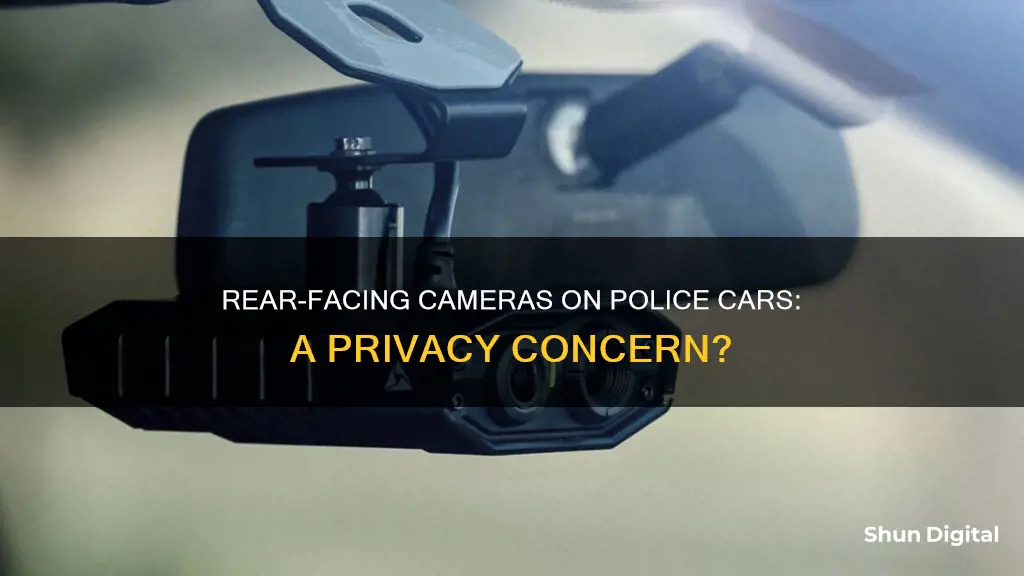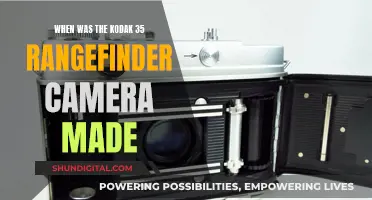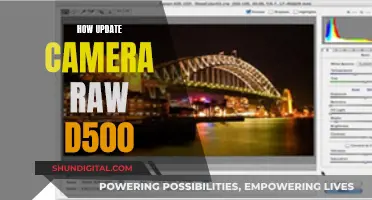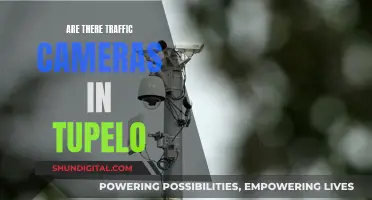
Police cars have come a long way in the last two decades, with new technologies being introduced to keep both officers and citizens safe. One of the most notable additions is the inclusion of cameras, with 72% of state patrol vehicles now utilizing in-vehicle camera systems. While some police cars have cameras on the trunks and roofs, which are used for automatic license plate reading, others have multiple-camera video systems that provide a panoramic view, including a rear-facing camera. These cameras are triggered by certain events, such as when emergency lights and sirens are turned on, and they provide an objective record of incidents, which can be used as evidence in court and to increase accountability.
| Characteristics | Values |
|---|---|
| Purpose | To provide an objective record of what the officer encounters, which can be used as evidence in court and to increase accountability by monitoring officer activity |
| Camera Positioning | One camera is positioned at the front windshield, another at the back, and two on the sides of the car built into the light bar |
| Activation | Some cameras are automatically activated by triggers such as emergency lights and sirens being turned on, while others need to be manually activated |
| Audio | Audio is typically activated by the officer pushing an event record button or automatically when the car's red lights are on or the car exceeds a certain speed |
| Storage | Recordings can be stored locally with up to 40 hours of video capacity, and some systems also allow for automatic wireless uploads to secure servers |
What You'll Learn
- Police car cameras can be automatically activated by triggers such as emergency lights and sirens
- Cameras can be manually activated by an officer
- Cameras can be set to turn on as soon as the car is started
- Cameras can be used to monitor officer activity and increase accountability and transparency
- Cameras can provide automatic digital evidence collection, protecting officers and citizens

Police car cameras can be automatically activated by triggers such as emergency lights and sirens
However, not all police car cameras are activated by triggers. In some cases, an officer may need to manually activate the camera. Additionally, the specific setup of police car cameras can vary depending on the department and their budget. Some cameras may have a delay in recording, starting only after the emergency lights have been turned on. Others may run constantly, providing updates and evidence on any given situation.
The use of police car cameras has become increasingly common in recent years. While only 11% of state police and highway patrol vehicles had in-vehicle camera systems in 2000, now almost 72% of all state patrol vehicles utilize this technology. This shift towards technology in law enforcement helps to ensure greater accountability and transparency in police interactions with the public.
Solar Power for Your Swann Cameras: A Guide
You may want to see also

Cameras can be manually activated by an officer
Police car cameras are hardwired into the vehicle's electrical systems, allowing them to be activated by programmed triggers. For example, a camera may automatically start recording when an officer turns on their emergency lights and siren. However, not all cameras are triggered this way, and some still require manual activation by an officer. This is because certain situations may not trigger the camera system to turn on automatically.
In some cases, an officer may need to manually activate the camera by pushing an event record button, such as during a traffic stop or other specific events. Additionally, the camera system can be set to turn on as soon as the police car is started, ensuring that every incident is recorded regardless of whether the officer remembers to activate it. This constant recording capability provides updates and evidence on any given situation.
The Palo Alto Police Department in California is an example of a department that has equipped its fleet with camera systems that can be manually activated by officers. The system includes five separate cameras that provide high-definition video and high-fidelity audio. One of these cameras is a rear-facing camera that offers a 270-degree view around the vehicle. The audio is activated when the officer pushes the event record button, providing a comprehensive record of the officer's encounters.
The manual activation of police car cameras ensures that officers have control over the recording process and can capture critical incidents that may occur during their shifts. This capability contributes to the overall effectiveness of police car camera systems in providing evidence, transparency, and accountability in law enforcement operations.
The Making of Akaso Cameras: Where Are They From?
You may want to see also

Cameras can be set to turn on as soon as the car is started
In recent years, there has been a significant increase in the use of technology in law enforcement. Police car cameras, body cameras, and high-tech squad cars are now commonly used to protect both officers and the public. In 2000, only 11% of state police and highway patrol vehicles had in-vehicle camera systems, but now, almost 72% do.
Police car cameras are hardwired into a vehicle's electrical system, allowing them to be activated by programmed triggers. For example, turning on emergency lights and sirens can automatically trigger the camera system to start recording. However, not all cameras have this capability, and some still need to be manually activated.
To address the issue of manual activation, some police car cameras are set to turn on as soon as the car is started. This ensures that every incident, inside and outside the car, is recorded, regardless of whether someone remembers to activate the camera. This feature is particularly important for providing an objective account of events, protecting officers from frivolous complaints, and ensuring officer accountability.
The Palo Alto Police Department in California is an example of a law enforcement agency that has implemented such a system. Their fleet of 26 police cars is equipped with a five-camera video system that automatically starts recording video as soon as the car is turned on. This system provides a 270-degree view around the vehicle, with one camera facing the front windshield, another facing the back, and two mounted on the sides. The fifth camera is focused on monitoring any prisoners in the back seat.
The automatic recording feature of the Palo Alto system ensures that up to 40 hours of video can be captured and stored. This allows officers to review and retrieve crucial footage, such as in the case of a reported burglary, where video from a side-view camera helped identify a suspect vehicle.
In conclusion, the ability to set police car cameras to turn on automatically when the car is started is a significant advantage for law enforcement agencies. It ensures that all interactions and incidents are recorded, providing an objective account of events, enhancing officer safety, and improving the quality of evidence collected.
Smartphone Cameras: Which Devices Shoot Raw?
You may want to see also

Cameras can be used to monitor officer activity and increase accountability and transparency
In recent years, police car cameras have become an increasingly common feature of law enforcement. These cameras can be used to monitor officer activity and increase accountability and transparency.
One example of a police department utilising this technology is the Palo Alto Police Department, which equipped its fleet of 26 cars with a multiple-camera video system in 2014. One of the five cameras in each car faces out of the rear windshield, providing a 270-degree view of the surrounding activity. The system automatically records video once the car is turned on and can capture up to 40 hours of footage. The recordings are used as evidence in court and to increase accountability by monitoring officer activity. Lt. Zach Perron, the police public affairs manager, stated that the cameras "protect our personnel against frivolous complaints and protect the public against impropriety from an officer".
The use of police car cameras can provide an objective account of incidents, capturing automatic digital evidence that can be used to protect both officers and citizens. For example, in DUI cases, dashcam footage can show a person's driving patterns before they were pulled over and their performance during field sobriety tests. This can help to either support or contradict claims made in a police report. Additionally, in cases of alleged police misconduct, dashcam recordings may provide video evidence of any violations of an individual's rights.
However, it is important to note that the use of police car cameras is not mandatory and varies across different police departments. Some departments utilise these cameras, while others do not. Additionally, there may be concerns about the large amount of data storage required for these systems, as well as the need for policies governing their usage.
Overall, police car cameras can be a valuable tool for monitoring officer activity, increasing accountability and transparency, and protecting the rights of both officers and citizens.
Cleveland Camera Tickets: What If You Don't Pay?
You may want to see also

Cameras can provide automatic digital evidence collection, protecting officers and citizens
In the last two decades, the world of law enforcement has evolved significantly, with technology becoming an integral part of policing. This has led to the adoption of various technological tools, such as police car cameras, body cameras, and high-tech squad cars, all aimed at enhancing the safety of both officers and citizens. One of the key benefits of these in-car camera systems is their ability to provide automatic digital evidence collection, which offers protection to both parties involved in police interactions.
Police car cameras are strategically positioned within the vehicle, often hardwired into the electrical systems, enabling them to activate based on specific triggers. These triggers can include the activation of emergency lights and sirens, or even the opening of the car doors. The cameras can automatically start recording, capturing vital evidence of incidents both inside and outside the police vehicle. This automatic evidence collection ensures that every encounter is documented, providing an objective account of events.
One notable example of the effectiveness of these camera systems is the case of a business owner reporting a burglary. By reviewing footage from a police car's side-view camera, officers were able to identify a suspect vehicle in the parking lot, aiding in the investigation. This demonstrates how the automatic digital evidence collection feature of these cameras can assist in solving crimes and bringing perpetrators to justice.
The integration of cameras in police cars offers numerous advantages. Firstly, they provide a panoramic view of the surroundings, with some systems offering up to a 270-degree field of vision. This comprehensive coverage ensures that any incident is captured from multiple angles, reducing the chances of missing crucial details. Additionally, the cameras can be programmed to activate in specific scenarios, such as when the vehicle exceeds a certain speed or is involved in an accident. This ensures that potentially critical footage is automatically recorded without relying solely on manual activation.
The automatic digital evidence collection provided by these camera systems serves as a protective measure for both officers and citizens. For officers, the footage can provide valuable proof of their actions, safeguarding them against false accusations or complaints. It also helps maintain transparency and accountability, ensuring that any improper conduct is identified and addressed. From a citizen's perspective, the cameras can capture any potential rights violations, providing evidence that can be used to seek justice if necessary.
Mastering Halo Reach: Free-Floating Camera Mode
You may want to see also
Frequently asked questions
Yes, police cars can have rear-facing cameras. In addition to the traditional dashboard camera, a multiple-camera video system installed on police cruisers can have one camera facing out the back windshield.
The purpose of the camera system is to help preserve an independent, objective record of what the officer encounters. The recordings are used as evidence in court and can also be used to increase accountability by monitoring officer activity.
The rear-facing cameras in police cars are hardwired into the vehicle's electrical systems and can be automatically activated based on programmed triggers. For example, the camera system can be set to turn on when the police car is started or when the emergency lights are turned on.







